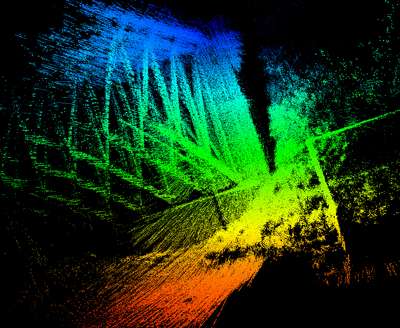Laser Odometry and Mapping (LOAM) is a real-time method for state estimation and mapping using a 3D lidar. Credit: Carnegie Mellon University, Department of Civil and Environmental Engineering
Imagine strapping on a harness and dangling yourself over the side of a bridge, 100 feet in the air—the wind whipping past you, the earth far below. It might sound like a scene from a spy movie, or a fun idea for a vacation activity. For a bridge inspector, however, it's just another day on the job.
But just because it's routine doesn't mean it's safe. When hanging by a tether from a bridge, accidents are always possible. Service cranes can tip over, workers can be crushed. The job of inspecting our bridges for potential dangers is essential to the safety of the thousands of people who cross them every day—but where there are humans, there's always the potential for error.
That's why Burcu Akinci, professor of Civil and Environmental Engineering at Carnegie Mellon University, wants to leave the dangerous work to the drones.
"Using drones to scan bridges for structural problems could provide data on the conditions of the bridge without putting people in high-risk situations," says Akinci. "We could then analyze this data using algorithms, to gain an objective assessment of bridge conditions."
Akinci, along with a team from the Robotics Institute led by Sanjiv Singh and a team at the Department of Civil and Environmental Engineering at Northeastern University led by Jerome Hajjar, have joined forces to develop the Aerial Robotic Infrastructure Analyst (ARIA). This tabletop-sized drone uses photo and video capture techniques, as well as state-of-the-art laser scanners, to create a high-resolution 3-D model of the bridge which can then be safely analyzed by an inspector on the ground. The project is made possible by a grant through the National Science Foundation National Robotics Initiative.
While infrastructure inspection is already being conducted in some cases by micro-air vehicles, ARIA is designed to be more than just a means of data gathering. As the drone flies autonomously around the bridge, it processes the data it gathers, providing feedback and suggestions while allowing the inspector on the ground to make assessments of the bridge in real-time. Then, after landing, the drone's onboard software can take the data it gathered and build a 3-D model of the bridge that inspectors can immerse themselves in to accurately visualize the structure without ever having to leave the ground.
Carnegie Mellon and Northeastern are pioneering this technology, and they predict that ARIA will be one of the first in a long line of robotic infrastructure inspection technologies. Already, the researchers are working on applying ARIA's capabilities to other infrastructure problems, such as the inspection and assessment of power transmission lines.
"The unique aspect of this team is that it combines the robotics perspective, the vision-based data processing perspective, and the civil engineering condition assessment and structural analysis perspectives," Akinci says. "This allows us to approach the complicated problem of infrastructure inspection from multiple perspectives and create a system that works for everyone involved in the process."
Thanks to this unique combination of perspectives, our bridges' near future will be safer for civilians above and below.
More information: For more information on the ARIA Project, visit: aria.ri.cmu.edu






















